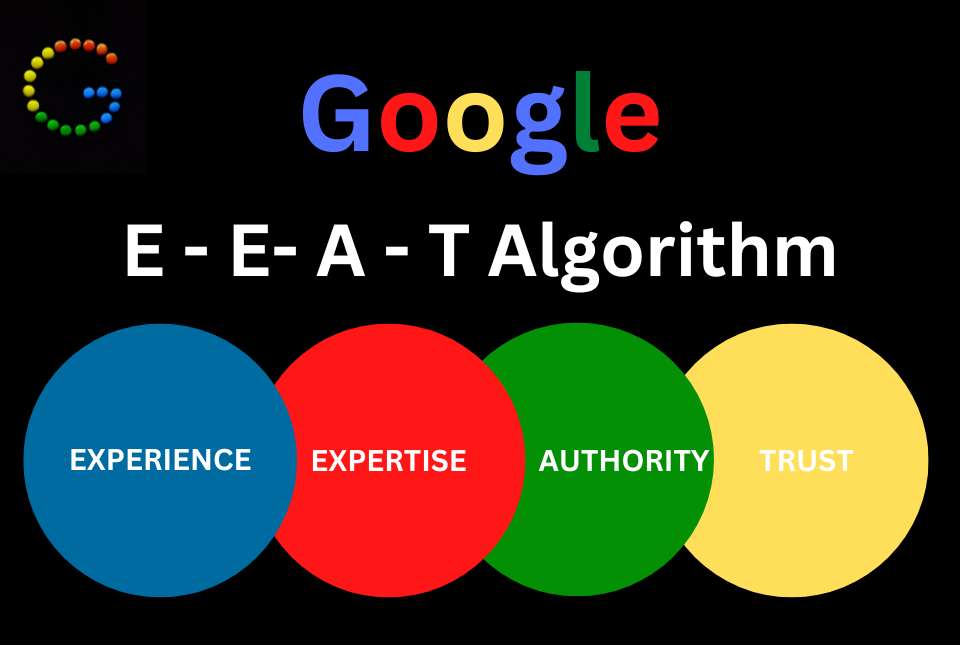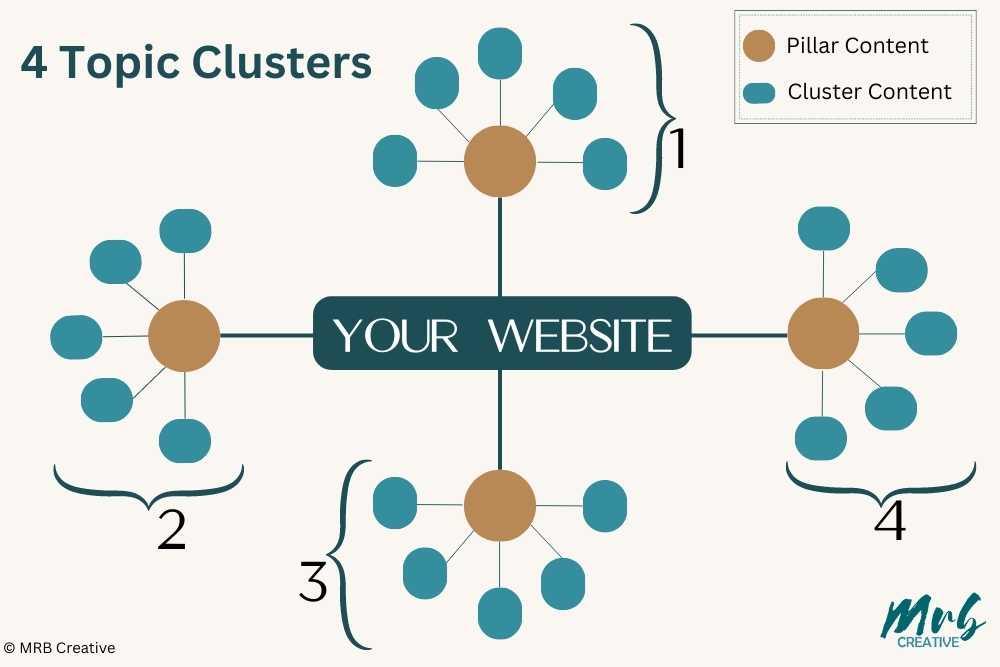Search Engine Optimisation (SEO) is crucial in determining the visibility of a website on search engine result pages (SERP’s). One strategy that has got significant attention recently is the use of topic clusters.
So what are topic clusters, why are they important for SEO, and how you can create and optimise your own topic clusters to enhance your Google rankings.
What is a topic cluster and why is it important for SEO?
A topic cluster is used in content marketing and SEO strategies to organise and interlink related pieces of content.
It involves creating a pillar page that serves as the main topic hub (pillar content), with multiple cluster content pieces linking back to the pillar page. This strategy helps search engines understand the topical relevance of your content, resulting in higher rankings and improved visibility.
How does a topic cluster contribute to SEO?
Topic clusters contribute to SEO by improving website structure and providing a clear hierarchy of information for search engines.
By linking related content through topic clusters, search engines can easily identify the main topic and understand the context of individual pages within a cluster. This helps search engines determine the relevance of your content, leading to higher rankings for your target keywords.
What is pillar content and how does it fit into the topic cluster structure?
A pillar page is a comprehensive piece of content that covers a broad topic related to your business or industry. It serves as the main hub for the topic cluster, linking back to all the related cluster content.
The pillar page provides in-depth information on the main topic, acting as a valuable resource for both users and search engines. It helps to establish your website’s authority and boosts SEO rankings.
Why is the topic cluster model effective for content marketing?
The topic cluster model is effective for content marketing because it allows you to cover a topic comprehensively and establish your website as an authoritative source of information.

Google uses the E-E-A-T algorithm which stands for Experience, Expertise, Authority, and Trust.
Creating topic clusters create signals to Google when it crawls your website and indexes these pages that you have expertise and authority on the topic, enhancing the trust of your website as a source of information.
By organising your content through topic clusters, you can provide valuable resources to your audience, encourage longer website visits, and increase the likelihood of backlinks.
This enhances your content marketing strategy and improves your website’s visibility in search results.
How do I create a topic cluster?
Creating a topic cluster involves careful planning and strategic implementation. Here are the key steps to follow:
1. What keyword research should I do for a topic cluster?
Keywords play a vital role in topic clusters. Start by identifying the main topic you want to rank for and conduct keyword research to find relevant long-tail keywords and related topics.
These keywords will help you determine the focus of your pillar content page and cluster content pages.
2. How do I link my cluster content to the pillar page?
Linking your cluster content to the pillar page is essential for the topic cluster strategy to work effectively.
Include internal links within your cluster content that direct users back to the pillar page. These links help search engines understand the interconnectivity of your content and strengthen the topical authority of your pillar page.
3. How can I optimize my cluster content for search engines?
To optimize your cluster content, ensure that each piece of content focuses on a specific keyword or subtopic within the broader topic covered by the pillar page.
Use relevant headings, subheadings, and internal links to create a cohesive structure. Additionally, optimize the meta tags, URLs, and image alt texts to improve the search engine visibility of your cluster content.
How do I get started with topic clusters?
If you’re new to topic clusters, you may need more detailed information.
Topic clusters can be confusing for those unfamiliar with the concept. Common questions include:
- Why do topic clusters matter in SEO?
- How can topic clusters improve my content marketing strategy?
- What are the benefits of using the topic cluster model?
Why do topic clusters matter in SEO?
Topic clusters matter in SEO because they help search engines understand the topical relevance of your content.
By organising your content through topic clusters, you make it easier for search engines to crawl, index, and rank your pages. This leads to higher visibility and improved rankings on search engine result pages (SERPs).
How can topic clusters improve my content marketing strategy?
Topic clusters can significantly improve your content marketing strategy.
By creating comprehensive and interlinked content, you provide a better user experience (UX), increase session duration, and encourage visitors to explore more of your website. All of these are also ranking factors for Google.
Topic clusters can also help you earn backlinks and establish your website as an authority in your industry.
Can I use topic clusters with existing content?
If you already have a substantial amount of content on your website, you can still implement topic clusters. Some steps to consider:
How can I identify core topics to build a topic cluster?
To build a topic cluster with existing content, identify the core topics that align with your business goals and target audience.
Analyze your current content and determine which pieces can be grouped together based on similarity or a shared theme. These core topics will form the foundation of your topic clusters.
How do I create content around a specific keyword within a topic cluster?
Once you have identified a specific keyword or subtopic within a topic cluster, create new content that focuses on that keyword.
Don’t use the same keyword though. Use long tail keywords (e.g. keyword phrases) that include the same keyword or a variation of it.
Ensure that the content provides valuable information to the audience and links back to the pillar page. This helps search engines understand the topical relevance and strengthens the overall topic cluster.
What is the impact of topic clusters on search engine results page rankings?
Topic clusters have a positive influence on search engine result page rankings.
By organising your content based on topic clusters, you create a cohesive structure that signals to search engines that your website is a reliable source of information. This helps search engines understand the context of your content and improves your chances of ranking higher for target keywords.
What are some examples of successful topic clusters?
A stand-out example is HubSpot, a leading marketing automation platform. They have done an excellent job of creating topic clusters around inbound marketing.
From their pillar page on inbound marketing, they have built a web of related content that covers various aspects of the topic, such as SEO, content marketing, and social media. This approach has not only helped them establish authority in the industry but has also aided in capturing organic traffic.
Another great example is Moz, a well-known name in the world of SEO.
They have leveraged topic clusters to create comprehensive guides on various SEO-related topics. One such example is their guide on local SEO. This pillar piece links to content on topics like keyword research, on-page optimisation, and link building, all of which are crucial elements of local SEO.
By creating these interconnected pieces, Moz has been able to provide value to their audience while also improving their search engine rankings.
Lastly, whether you love or hate him, we can’t ignore the success of Neil Patel, a renowned digital marketing expert.
He has created topic clusters around a wide range of marketing and SEO topics. What sets his approach apart, is the inclusion of video content. By integrating video content into his topic clusters, Neil Patel has been able to cater to different learning styles and capture the attention of a wider audience.
These 3 examples demonstrate the enormous power of topic clusters in building authority, driving organic traffic, and providing value to readers.
How do topic clusters help with inbound marketing?
Inbound marketing focuses on attracting and engaging potential customers through valuable content.
Topic clusters help with inbound marketing by providing a comprehensive and interconnected network of content pieces. This not only enhances the user experience but also increases the chances of attracting organic traffic, generating leads, and ultimately converting them into customers.
How can I structure content around a broad topic using topic clusters?
When structuring content around a broad topic, topic clusters provide an effective framework. Start with a pillar page that covers the main topic in-depth.
Then, create cluster content that focuses on specific subtopics or related aspects of the main topic. Link these cluster content pieces back to the pillar page to establish a topic hierarchy and improve search engine visibility.
What are some specific keyword strategies for building a topic cluster?
Keyword strategies play a crucial role in building topic clusters.
You can use a combination of broad and long-tail keywords to create a comprehensive cluster. Identify the main keywords for the pillar page and use related long-tail keywords for the cluster content. This helps search engines understand the relevance of your content to the main topic and improves your chances of ranking for various keywords.
Implementing topic clusters can be a game-changer for your Search Engine Optimisation and content marketing strategies.
By organising your content effectively and focusing on relevant keywords, you can improve your website’s visibility on search engines and attract more organic traffic.
Start thinking about topic clusters and leverage the power of this SEO secret to boost your rankings on Google and other search engines.
Topic Cluster FAQ’s
Q: What are topic clusters and how can they improve my Google rankings?
A: Topic clusters are a content strategy that involves creating a group of interlinked pages centered around a specific topic, with a pillar page as the main hub. This model helps search engines understand the relationships between different pieces of content, which can improve your rankings.
Q: How do I create a topic cluster?
A: To create a topic cluster, start by choosing a core topic that is relevant to your audience.
Then, create a pillar page that provides a comprehensive overview of that topic.
Finally, create cluster pages that cover different subtopics within the core topic and internally link them to the pillar page.
Q: Why are topic clusters important for SEO?
A: Topic clusters are important for SEO because they help search engines understand the structure and relevance of your content. By organising your content around a central theme and linking related pages together, you signal to search engines that your website is an authority on the topic, which can lead to higher rankings.
Q: Can you provide some examples of topic clusters?
A: Sure! Let’s say you have a website about fitness. Your core topic could be “Weight Loss,” and your pillar page could be an in-depth guide on different weight loss strategies. Cluster pages could then cover specific topics like “Healthy Eating for Weight Loss,” “Effective Exercises for Weight Loss,” and “Lifestyle Changes to Support Weight Loss.”
Q: How many pages should be in a topic cluster?
A: The number of pages in a topic cluster can vary depending on the depth and breadth of your topic.
Ideally, your pillar page should cover the main topic comprehensively, and you can have multiple cluster pages that address different subtopics.
There is no set rule for the exact number of pages but aim for a content-rich cluster that provides value to your audience.
Q: How do topic clusters help with content marketing?
A: Topic clusters help with content marketing by providing a strategic framework for organising and structuring your content. They allow you to create a comprehensive resource for your audience while improving your website’s visibility and rankings in search engines.
Q: What is the difference between a pillar page and a cluster page?
A: A pillar page is a high-level overview of a core topic, providing a comprehensive guide. –
On the other hand, cluster pages delve into specific subtopics related to the core topic. Pillar pages act as a hub, linking to cluster pages and helping to establish the overall structure and content interlinking for the topic cluster.
Q: How can I find the right core topic for my topic cluster?
A: To find the right core topic, consider your target audience, industry trends, and keyword research. Look for topics that are relevant, popular, and have a good search volume but also align with your expertise and goals.
Q: Is a topic cluster approach beneficial for every topic?
A: While a topic cluster approach can be beneficial for many topics, it may not be suitable for every single topic. Some topics may not have enough related subtopics or may not require such a comprehensive cluster strategy.
It’s important to assess whether a topic cluster approach aligns with your content goals and the needs of your audience.
Q: Can topic clusters be used in any type of content or content marketing strategy?
A: Yes, topic clusters can be used in various types of content and content marketing strategies.
Whether you’re writing blog posts, creating videos, or developing guides, you can apply the topic cluster model to organise and structure your content around a specific core topic.










